英语知识点北师大版英语四下《Unit10》教学设计-总结
- 格式:doc
- 大小:18.00 KB
- 文档页数:2
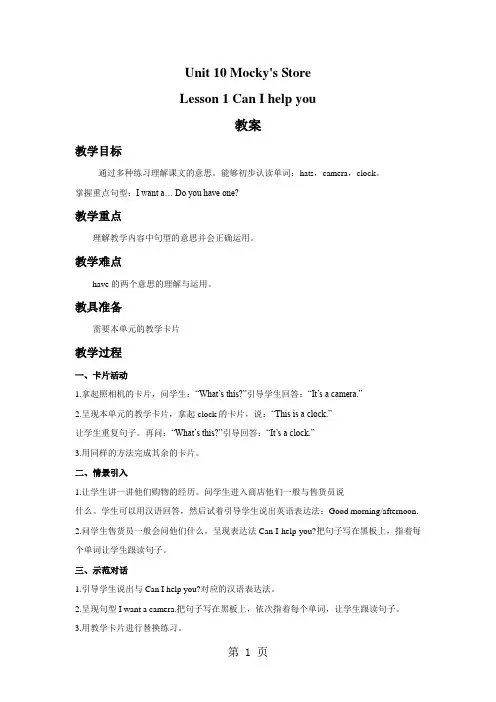
Unit 10 Mocky's StoreLesson 1 Can I help you教案教学目标通过多种练习理解课文的意思。
能够初步认读单词:hats,camera,clock。
掌握重点句型:I want a… Do you have one?教学重点理解教学内容中句型的意思并会正确运用。
教学难点have的两个意思的理解与运用。
教具准备需要本单元的教学卡片教学过程一、卡片活动1.拿起照相机的卡片,问学生:“What’s this?”引导学生回答:“It’s a camera.”2.呈现本单元的教学卡片,拿起clock的卡片,说:“This is a clock.”让学生重复句子。
再问:“What’s this?”引导回答:“It’s a clock.”3.用同样的方法完成其余的卡片。
二、情景引入1.让学生讲一讲他们购物的经历。
问学生进入商店他们一般与售货员说什么。
学生可以用汉语回答,然后试着引导学生说出英语表达法:Good morning/afternoon.2.问学生售货员一般会问他们什么。
呈现表达法Can I help you?把句子写在黑板上,指着每个单词让学生跟读句子。
三、示范对话1.引导学生说出与 Can I help you?对应的汉语表达法。
2.呈现句型I want a camera.把句子写在黑板上,依次指着每个单词,让学生跟读句子。
3.用教学卡片进行替换练习。
4.全班分成两组。
每次举起一张卡片,让一组说:“Good morning. Can I help you?”另一组回答:“I want a (camera).”5.每次举起新的卡片的时候让学生互换角色。
6.呈现句型Do you have a camera?告诉学生这是比I want a camera?更礼貌的说法。
7.重复上述步骤,拿起一张卡片,让一组学生说:“Do you have a (camera)?”另一组学生应该回答:“Yes, I do.”8.全班一起复习颜色的词汇。
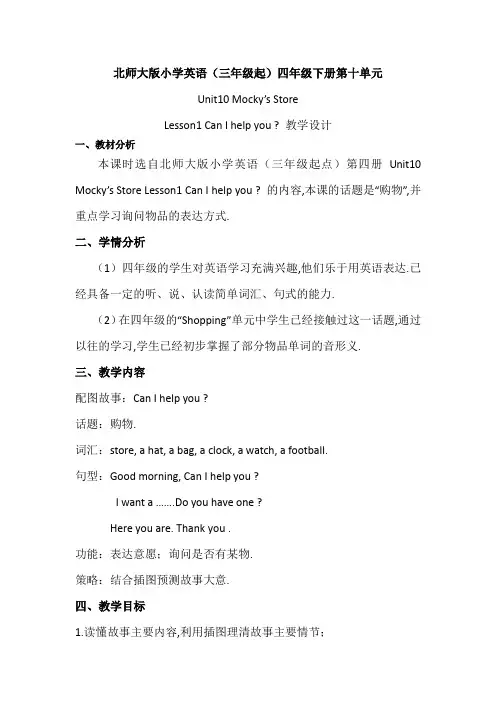
北师大版小学英语(三年级起)四年级下册第十单元Unit10 Mocky’s StoreLesson1 Can I help you ? 教学设计一、教材分析本课时选自北师大版小学英语(三年级起点)第四册Unit10 Mocky’s Store Lesson1 Can I help you ? 的内容,本课的话题是“购物”,并重点学习询问物品的表达方式.二、学情分析(1)四年级的学生对英语学习充满兴趣,他们乐于用英语表达.已经具备一定的听、说、认读简单词汇、句式的能力.(2)在四年级的“Shopping”单元中学生已经接触过这一话题,通过以往的学习,学生已经初步掌握了部分物品单词的音形义.三、教学内容配图故事:Can I help you ?话题:购物.词汇:store, a hat, a bag, a clock, a watch, a football.句型:Good morning, Can I help you ?I want a …….Do you have one ?Here you are. Thank you .功能:表达意愿;询问是否有某物.策略:结合插图预测故事大意.四、教学目标1.读懂故事主要内容,利用插图理清故事主要情节;2.模仿人物对话正确朗读故事;3.借助图片正确指认和说出物品词汇;4.在故事中正确理解购物、表达意愿、询问是否有某物等表达法的意思.五、教学重点和难点重点:借助插图理解并正确朗读故事.难点:在故事中正确理解购物常用语等主要表达法的意思.六、教学过程Step1.Warm up(1)Greetings.Good morning children.Step2.Lead in1、Have a guess.2、T alk about Mocky.T: What is Mocky doing?S:Mocky is writing. (Mocky’s store)T:Wow, Mocky has a store. Do you have one?S:Yes, I do. / No, I don’t.T:Yeah, Mocky has a store. So what does Mocky saywhen somebody comes?S:Good morning, Can I help you ? 引出课题:Unit10 Mocky’s StoreLesson1 Can I help you ?Step3.Presentation1、Predict and watch. 整体感知,语篇全文.Who is coming to Mocky’s store?Lulu Danny播放动画让学生带着问题观看故事.2、Read and circleWhat do Lulu and Danny want ?再次播放动画让学生认读,圈出Lulu和Danny想要的物品.3、Understand the text(1)What does Lulu want ?“camera”: I want a camera .Do you have one ?“hat”: I like the blue one, please.(2)What does Danny want ?“clock”: I want a clock . Do you have one ?Step4.Read the story1.Listen and follow. Pay attention to the pronunciationand emotion.2.Read in groups.3.Summarize the story.Step5.Learn to sayT:Let’s go to Mocky’s store,again.1.T alk about AnnAnn comes to Mocky’s store. Guess,what does Ann want?2.Learn to say new words“bag”: I want a bag. Do you have one ?“watch”: I want a watch. Do you have one ?“football”: I want a football. Do you have one ?3.Play a game用句型:”Good morning, Can I help you ? I want a …….Do you have one ? Here you are. Thank you .“Step6.AssignmentTry to design a second-hand fair.。

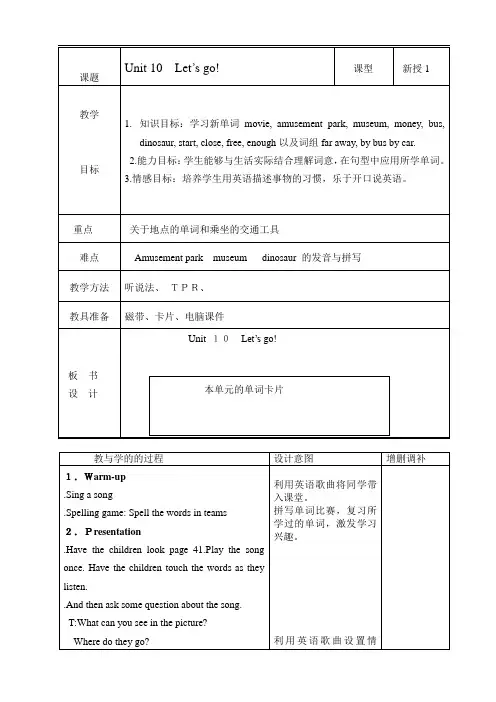
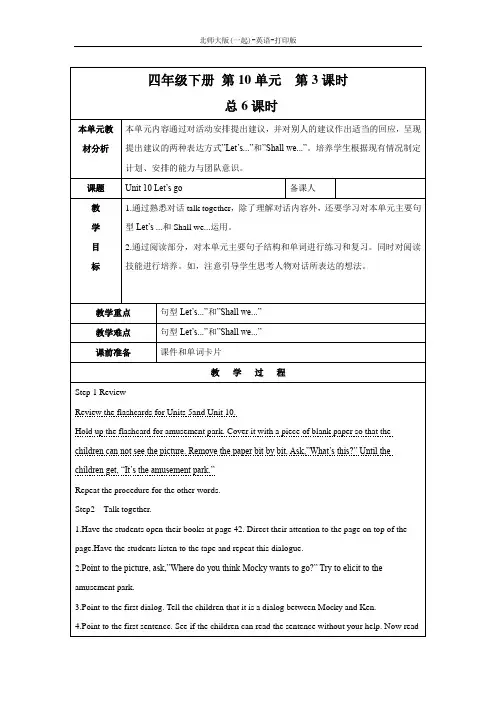
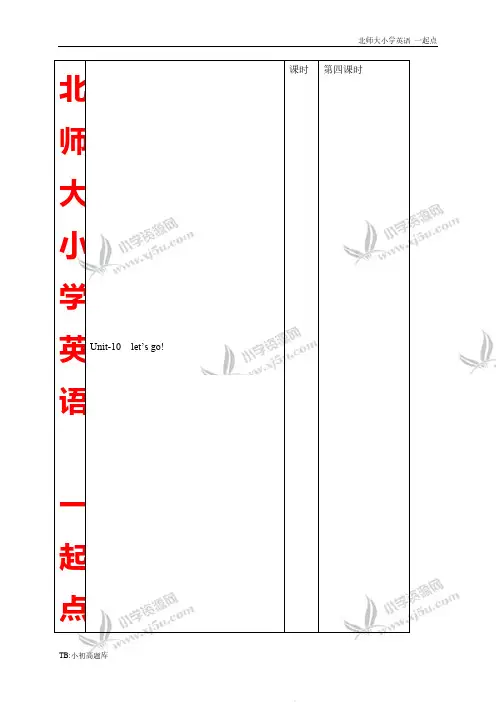
北师大小学英语一起点Unit-10 let’s go!课时第四课时四年级英语知识需要巩固背诵单词和课文不要粗心大意。
北师大小学英语一年级起点伴成长快乐学习!课题教材分析Key points4-skilled words: a movie an amusement park a museum money a bus a dinosaur far away start close by busby car free enoughNew structures: Let’s …. Shall we …? Do we have enough time/money? Yes, we do./ No, we don’t. Pronunciation: Sounds and letters: “air”, “ear”, “are”教学目标1.The students can read the words and recognize the words preliminary.2. The students can describe the time and activities in English.3. The students can grasp how to pronounce “air”, “ear”, “are”4. Developing the pupil’s ability of co-operation by group work.课前准备Courseware, audiocassette recorder, new words cards板书设计Unit 10 Let’s go!Let’s …. Shall we …?Do we have enough time/money? Yes, we do./ No, we don’t.教学活动设计设计意图Step1. Warm up:T: Class begins! Morning! Boys and girls!S: Morning ,teacher!T: What day is it today?S: It’s / Today is…T: What do you do on weekend?S: I do my homework.T: Do you have much homework?S: Yes, we do.T: Do you have enough time to do it?S: Sometimes we do, sometimes we don’t.Step 2. Review1. Review the flashcards for Units 5 and 10.2. hold up the flashcard for school. Cover it with a piece of blank paper so that the children can not see the picture. Remove the blank paper bit by bit. Ask, “What’s this?” until the children get, “It’s a ( school ).”3. Repeat for the other flashcards.Step 3. Mary’s new bag1. Draw the children’s attention to the picture on page 43 and tell them that they are going to read about a girl who wants a new school bag.2. Point to the pictures on the page. Ask the children to talk about who they can see in the pictures and have them guess what the story is probably about.3. Direct the children’s attention to the text. Have the children read the text by themselves silently.4. When all the children finished, read the text slowly to the children. Make sure they all understand the Practise the students’ listening And speakingAsk the children to know the new languages of this unit.Practice the new sentences.meaning of each sentence.5. Read the first paragraph slowly again to the children. Then stop to ask children which picture matches these paragraph. Have the children point to thepicture. Check if they all number it correctly.6. Repeat with the other parts of the text.7. Now have the children look at the second activity. Tell them to answer the questions, and that the text contains the information for the questions.8. Read the first question and elicit the answer from the children. Then have them elicit out the answer on the line.9. Repeat with the other questions.Step 4. ExtendMake a new dialog.Step 5. Sum up: Raise the students using the sentences ability作业设计Must do:1. Read the new text 5 times at home.2. Translate the text into Chinese.3. Preview page 45, 46, 47 Choosing do:Read a new story by yourself.教学反思本节课让学生在学会提建议后,充分发挥自己的想象,自己做对话,一开始给学生了四个情景,发现学生说的很好,最好扩展练习直接发散了学生的思维,取得了意想不到的效果。
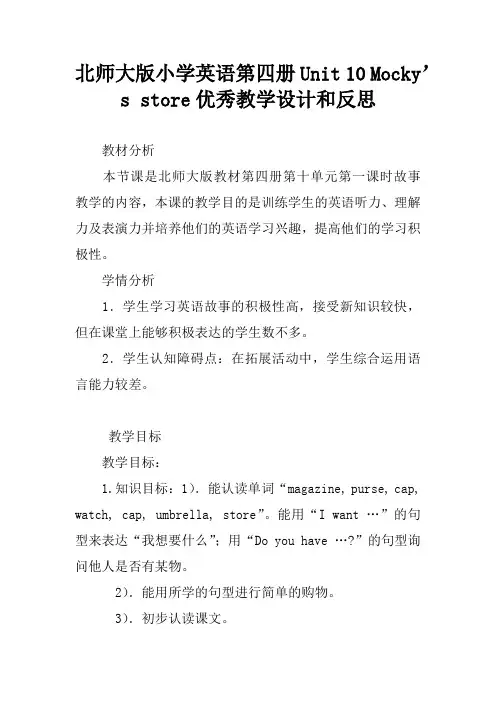
北师大版小学英语第四册Unit 10 Mocky’s store优秀教学设计和反思
教材分析
本节课是北师大版教材第四册第十单元第一课时故事
教学的内容,本课的教学目的是训练学生的英语听力、理解
力及表演力并培养他们的英语学习兴趣,提高他们的学习积
极性。
学情分析
1.学生学习英语故事的积极性高,接受新知识较快,
但在课堂上能够积极表达的学生数不多。
2.学生认知障碍点:在拓展活动中,学生综合运用语
言能力较差。
教学目标
教学目标:
1.知识目标:1).能认读单词“magazine, purse, cap, watch, cap, umbrella, store”。
能用“I want …”的句
型来表达“我想要什么”;用“Do you have …?”的句型询
问他人是否有某物。
2).能用所学的句型进行简单的购物。
3).初步认读课文。
2.能力目标:能利用所学的词汇和句子到商店买东西,提高综合语言运用能力,解决实际生活中的问题。
3.情感目标:让学生学会独立买东西。
教学重点和难点
1、听懂、会说“I want …. Do you have …?”,并能在一定情景中运用。
2、能认读理解课文出现的句子“You can’t sell those things. They aren’t your things.”。
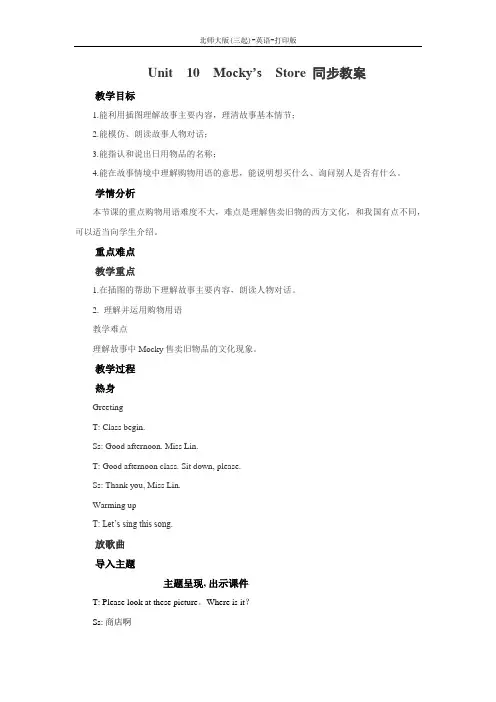
Unit10Mocky’s Store 同步教案教学目标1.能利用插图理解故事主要内容,理清故事基本情节;2.能模仿、朗读故事人物对话;3.能指认和说出日用物品的名称;4.能在故事情境中理解购物用语的意思,能说明想买什么、询问别人是否有什么。
学情分析本节课的重点购物用语难度不大,难点是理解售卖旧物的西方文化,和我国有点不同,可以适当向学生介绍。
重点难点教学重点1.在插图的帮助下理解故事主要内容,朗读人物对话。
2. 理解并运用购物用语教学难点理解故事中Mocky售卖旧物品的文化现象。
教学过程热身GreetingT: Class begin.Ss: Good afternoon. Miss Lin.T: Good afternoon class. Sit down, please.Ss: Thank you, Miss Lin.Warming upT: Let’s sing this song.放歌曲导入主题主题呈现, 出示课件T: Please look at these picture。
Where is it?Ss: 商店啊T: Yes, this is store.We can buy some things in this place.(板书 store)全班认读单词store2. 呈现单词单词呈现1. 呈现单词1)师:Ok, Let’s look, what are selling things in this store? Please look at picture1.What is this?S: 书包,bag.师:Great! A bag全班跟读2)用同样的方法依次利用课件呈现课文单词a clock, a watch, a football, a camera, a hat课文故事内容呈现3、情景剧导入师用实物布置一家小商店。
T:This is a store. There are many things in the store. Do you want to get them.?Ss: Yes.T: Ok, but I hope you can to be a seller and a customer. Let us know, what is “Chinese shopping”. Who want to try? You can speak Chinese.Ss 举手两名学生表演简单的小短剧。
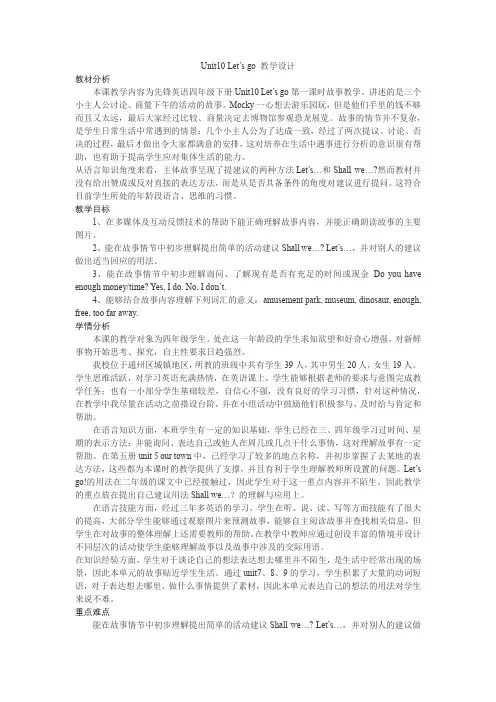
Unit10 Let’s go 教学设计教材分析本课教学内容为先锋英语四年级下册Unit10 Let’s go第一课时故事教学。
讲述的是三个小主人公讨论、商量下午的活动的故事。
Mocky一心想去游乐园玩,但是他们手里的钱不够而且又太远,最后大家经过比较、商量决定去博物馆参观恐龙展览。
故事的情节并不复杂,是学生日常生活中常遇到的情景:几个小主人公为了达成一致,经过了两次提议、讨论、否决的过程,最后才做出令大家都满意的安排,这对培养在生活中遇事进行分析的意识很有帮助,也有助于提高学生应对集体生活的能力。
从语言知识角度来看,主体故事呈现了提建议的两种方法Let’s…和Shall we…?然而教材并没有给出赞成或反对直接的表达方法,而是从是否具备条件的角度对建议进行提问。
这符合目前学生所处的年龄段语言、思维的习惯。
教学目标1、在多媒体及互动反馈技术的帮助下能正确理解故事内容,并能正确朗读故事的主要图片。
2、能在故事情节中初步理解提出简单的活动建议Shall we…? Let’s…,并对别人的建议做出适当回应的用法。
3、能在故事情节中初步理解询问、了解现有是否有充足的时间或现金Do you have enough money/time? Yes, I do. No, I don’t.4、能够结合故事内容理解下列词汇的意义:amusement park, museum, dinosaur, enough, free, too far away.学情分析本课的教学对象为四年级学生。
处在这一年龄段的学生求知欲望和好奇心增强,对新鲜事物开始思考、探究,自主性要求日趋强烈。
我校位于通州区城镇地区,所教的班级中共有学生39人,其中男生20人,女生19人。
学生思维活跃,对学习英语充满热情,在英语课上,学生能够根据老师的要求与意图完成教学任务;也有一小部分学生基础较差,自信心不强,没有良好的学习习惯,针对这种情况,在教学中我尽量在活动之前搭设台阶,并在小组活动中鼓励他们积极参与,及时给与肯定和帮助。
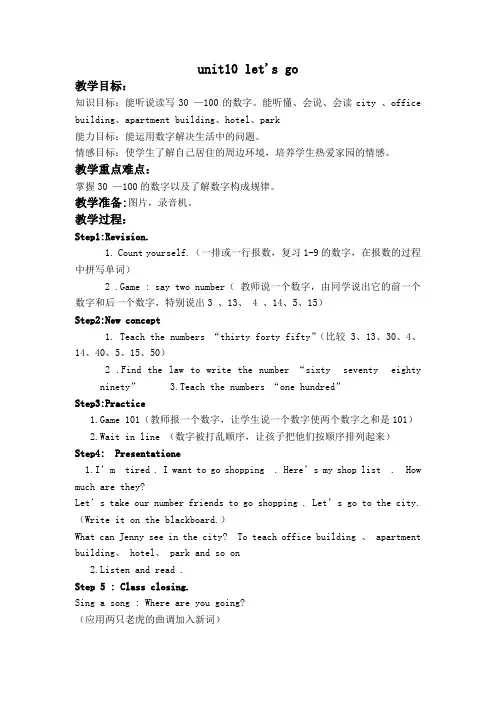
unit10 let's go教学目标:知识目标:能听说读写30 —100的数字。
能听懂、会说、会读city 、office building、apartment building、hotel、park能力目标:能运用数字解决生活中的问题。
情感目标:使学生了解自己居住的周边环境,培养学生热爱家园的情感。
教学重点难点:掌握30 —100的数字以及了解数字构成规律。
教学准备:图片,录音机。
教学过程:Step1:Revision.1. Count yourself.(一排或一行报数,复习1-9的数字,在报数的过程中拼写单词)2 .Game : say two number(教师说一个数字,由同学说出它的前一个数字和后一个数字,特别说出3 、13、4 、14、5、15)Step2:New concept1. Teach the numbers “thirty forty fifty”(比较3、13、30、4、14、40、5、15、50)2 .Find the law to write the number “sixty seventy eightyninety” 3.Teach the numbers “one hundred”Step3:Practice1.Game 101(教师报一个数字,让学生说一个数字使两个数字之和是101)2.Wait in line (数字被打乱顺序,让孩子把他们按顺序排列起来)Step4: Presentatione1.I’m tired . I want to go shopping . Here’s my shop list . How much are they?Let’s take our number friends to go shopping . Let’s go to the city. (Write it on the blackboard.)What can Jenny see in the city? To teach office building 、 apartment building、 hotel、 park and so on2.Listen and read .Step 5 : Class closing.Sing a song : Where are you going?(应用两只老虎的曲调加入新词)板书设计:课后反思:。
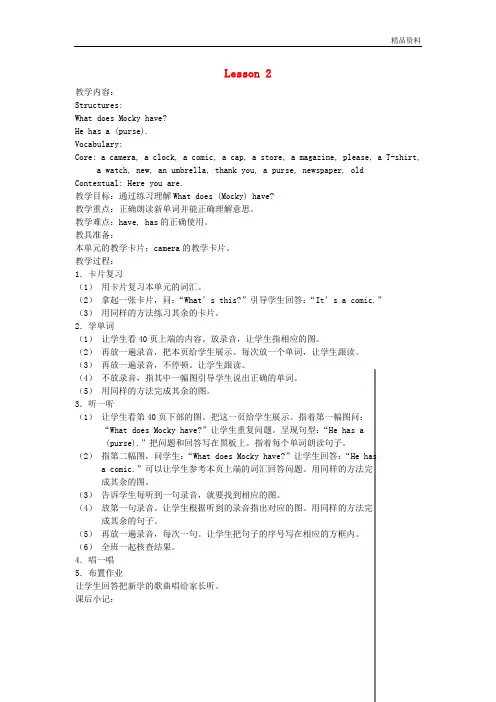
精品资料Lesson 2教学内容:Structures:What does Mocky have?He has a (purse).Vocabulary:Core: a camera, a clock, a comic, a cap, a store, a magazine, please, a T-shirt,a watch, new, an umbrella, thank you, a purse, newspaper, oldContextual: Here you are.教学目标:通过练习理解What does (Mocky) have?教学重点:正确朗读新单词并能正确理解意思。
教学难点:have, has的正确使用。
教具准备:本单元的教学卡片;camera的教学卡片。
教学过程:1.卡片复习(1)用卡片复习本单元的词汇。
(2)拿起一张卡片,问:“What’s this?”引导学生回答:“It’s a comic.”(3)用同样的方法练习其余的卡片。
2.学单词(1)让学生看40页上端的内容。
放录音,让学生指相应的图。
(2)再放一遍录音,把本页给学生展示。
每次放一个单词,让学生跟读。
(3)再放一遍录音,不停顿。
让学生跟读。
(4)不放录音,指其中一幅图引导学生说出正确的单词。
(5)用同样的方法完成其余的图。
3.听一听(1)让学生看第40页下部的图。
把这一页给学生展示。
指着第一幅图问:“What does Mocky have?”让学生重复问题。
呈现句型:“He has a(purse).”把问题和回答写在黑板上。
指着每个单词朗读句子。
(2)指第二幅图,问学生:“What does Mocky have?”让学生回答:“He hasa comic.”可以让学生参考本页上端的词汇回答问题。
用同样的方法完成其余的图。
(3)告诉学生每听到一句录音,就要找到相应的图。
(4)放第一句录音。
让学生根据听到的录音指出对应的图。
课题Unit 10 Let’s go!课型新授时数9教学目标(重点☆难点△) 一、知识目标与能力目标☆学生能够认读、听辨、默写Words to learn 中的个单词;☆能够认读、听辨单词表中相关词汇;☆学生能够听辨、认读并使用功能句型☆能够认读、听辨字母组合的发音;△能够整体感知text,能力水平较高的学生能够表演;△能够独立完成阅读;△能感知story time,能力水平较高的学生能够表演能够说唱歌谣,并理解其含义。
二、情感、策略、文化等有关目标培养学生的合作精神和创新意识,引导学生通过以旧带新的方式自主学习,同时也要注重合作学习。
课前准备教学过程中所需的图片、录音、课件、动画素材,以及上课时的单词卡片。
教师准备相关媒体的播放设备,如录音机、电视、电脑等。
科研课题落实严格“六规范”,提高课堂质量。
随着学习内容的扩展,教师需要通过认真备课,认真设计,有意识、有计划地培养学生的合作精神和创新意识,引导学生通过以旧带新的方式自主学习,同时也要注重合作学习。
板书设计Unit 10 L et’s go! Let’s …. Shall we …?Do we have enough time/money? Yes, we do./ No, we don’t.课后小结作业设计1. Read the text 5 times.2. Copy the new words.3. Preview next lesson.选做:小组表演课文或者背诵课文教学过程第( 1 )课时Text基础设计集备后修改、补充Step1. Warm up:T: Class begins!Morning! Boys and girls!S: Morning ,teacher!T: What day is it today?S: It’s / Today is…T: What do you do on weekend?S: I do my homework.T: Do you have much homework?S: Yes, we do.T: Do you have enough time to do it?S: Sometimes we do, sometimes we don’t.Step 2. Review1. Review the flashcards for Unit 9. Hold up the flashcard for morning. Ask, “Is this morning, afternoon, or night?” Elicit, “It’s morning.”2. Repeat for afternoon, night, and breakfast, lunch, and dinner.Step 3. Set the sceneIn Chinese ask the children what they usually do on Sunday. Ask them if they like to go to the movies, or to an amusement park..Step 4. Model the dialog1. Present the expression, Let’s go to a movie. Write the sentence on the board and explain its meaning. read the sentence aloud, pointing to each word as you do so. Have the children repeat the sentence after you.2. Explain that in English we often say Let’s or Shall we when we make a suggestion, for example, Le t’s go to the perk or Shall we go to the zoo. Now present the Text1. “this afternoon”Understand the meaning of “this” here.2. “There be”“There’s a good movie at the movie theater.”3. “What time does it start?”“It starts at three o’clock”(The sentences are the combination of the key structures in Unit 7 to Unit 9. Still remember the first presentation of the word “start”?)4. “Let’s call the movie theater.”Focus on “call”“There’s a telephone. Call an ambulance, Ken!” (Book 7 Unit 1 text)5. “Excuse me.” (Book 7 Unit 5 “Talk together”, “Uncle Booky’s Blackboard”)6. Key structures:Do you have enough time/money?Shall we go to the amusement park? (making suggestions)7. “But it’s too far away.”Work on the phrase “far away”.“far” (Book 7 Unit 2 chant)“too” (Book 6 Unit 9 Uncle Booky’s Story time)8. “What shall we do then?”Work on the function of “shall”.New word: then9. Pronunciation of the word “close”. (v./ adj.)10. “Let’s go there by bus.”(Remember the phrase “by bus” in the chant of Unit 9?)Must do: 1. Read the new text 5 times2. Copy the new text 2E 1C3. Recite the new text and words.4. Preview Page 40, 45教学过程第( 2 )课时Words to learn,Uncle Booky’s Blackboard 教学过程集备后修改、补充Step1. Warm up:T: Class begins! Morning! Boys and girls! S: Morning ,teacher!T: What day is it today? S: It’s / Today is…T: What do you do on weekend?S: I do my homework.T: Do you have much homework?S: Yes, we do.T: Do you have enough time to do it?S: Sometimes we do, sometimes we don’t.Step 2. Review1. Have the children open to the story pages of this Unit. Tell them they are now Mocky. Explain that you are going to play the tape and you want them repeat what Mocky said.2. Play the tape. Have the children repeat what Mocky said after the tape.Step 3. Words to learn1. Have the children open their books at page 40. Direct the children’s attention to the top half of the page. As you play the tape, have them touch the matching words or pictures.2. Replay the tape while showing your copy of the page. Stop the tape after each word and have the children repeat the words.3. Play the tape again without stopping. Have the children say the words along with the tape.4. Without playing the tape, point to one of the pictures or word from the children.5. Repeat the procedure for all the other pictures and words. Words to learnSame meaning:a movie / movie theater / the moviesUncle Booky’s BlackboardKey structure:Let’s ….Shall we …?Do we have enough time/money? Yes, we do./ No, we don’t.教学过程第( 3 )课时Listen to this,Let’s sing!(Play the game),Talk together,Listen and Match基础设计集备后修改、补充Step1. Warm up:T: Class begins!Morning! Boys and girls! S: Morning ,teacher!T: What day is it today? S: It’s / Today is…T: What do you do on weekend? S: I do my homework.T: Do you have much homework? S: Yes, we do.T: Do you have enough time to do it?S: Sometimes we do, sometimes we don’t.Step 2. Review1. Have the children open to the story pages of this Unit. Tell them they are now Mocky. Explain that you are going to play the tape and you want them repeat what Mocky said.2. Play the tape. Have the children repeat what Mocky said after the tape.Step 3. Listen to this1. Direct the children’s attention to the pictures and watches at the bottom of the page. Point to the first picture and ask, “What is Ken doing?” If necessary, have the children refer to the vocabulary at the top of the page for their answer. Elicit, “He is playing football.”2. Repeat this procedure for the other pictures .3. Explain to the children that they will hear a sentence on the tape and they must match it to the correct picture.4. Play the tape, stopping after each sentence. Have the children touch the corresponding picture. Make sure that they are all touching the correct picture before you continue.5. Play the tape again, stopping after each sentence. Explain that this time you want the children to number the pictures according to their order on the tape.6. Review the sentences in a class drill.Step 4. Let’s Sing Listen to thisStructure:Let’s ….Let’s sing!1. “We can take the bus.” (Unit 9 chant)Tell the students that they can also say “We can go by bus.”2. New word: city (will appear in Unit 11 “Listen and Write”)3. “You can come with us.”Focus on the usage of “with”.Talk togetherStructure:A: Let’s go to the ….B: Do we have enough time/money?A: Yes, we do. It’s only three o’clock./ No, we don’t. We have only seven yuan.Listen and Number(Same with “Talk Together”)教学过程第( 4 )课时Reading Comprehension基础设计集备后修改、补充Step1. Warm up:Step 2. Review1. Review the flashcards for Units 5 and 10.2. hold up the flashcard for school. Cover it with a piece of blank paper so that the children can not see the picture. Remove the blank paper bit by bit. Ask, “What’s this?” until the chi ldren get, “It’s a ( school ).”3. Repeat for the other flashcards.Step 3. Mary’s new bag1. Draw the children’s attention to the picture on page 43 and tell them that they are going to read about a girl who wants a new school bag.2. Point to the pictures on the page. Ask the children to talk about who they can see in the pictures and have them guess what the story is probably about.3. Direct the children’s attention to the text. Have the children read the text by themselves silently.4. When all the children finished, read the text slowly to the children. Make sure they all understand the meaning of each sentence.5. Read the first paragraph slowly again to the children. Then stop to ask children which picture matches these paragraph. Have the children point to the picture. Check if they all number it correctly.6. Repeat with the other parts of the text.7. Now have the children look at the second activity. Tell them to answer the questions, and that the text contains the information for the questions.8. Read the first question and elicit the answer from the children. Then have them elicit out the answer on the line. Reading Comprehension1. “She talks with her mom.”Focus on the usage of “with”.2. “A new bag again?”“again” (Book 5 Unit 1; Book 8 Unit 7 “Let’s sing!”)3. “Dad is talking on the telephone.”Work on the meaning.4. “On Monday morning, ….”Usage of the preposition “on”.5. “Mary goes to school happily with her ‘new’ schoolbag.”“happily”, the first t ouch of adverb.教学过程第( 5 )课时Touch, Ask and Answer,Writing Exercises,Let’s chant!基础设计集备后修改、补充Step 1 Warm-up1. Act the text.2. Play a guessing game.Step2 Presentation1. Touch, ask and answer.Ask and answer in pairs.2. Read and write1) Open the books at P10 read and complete the exercise.2) Read the question by each word. Have the children repeat the question as they touch each word in their books.3) Practice these questions and answers.3. Let’s chant1) Look at the picture and answer:What does he/she do?2) Read the chant sentence by sentence.3) Listen to the tape and repeat.4) Try to act in teams.Step3 ConsolidationReview the sentences.Step4 Homework1. Copy the sentences 4E1C.2. Preview next lesson. Touch, Ask and AnswerA: Let’s go to the ….B: Do we have enough money?A: Yes, we do.B: How much is the ticket?A: It’s ….(“How much …” Book 5 Unit 2, Book 7 Unit 3; “ticket” Book 6 Unit 12)Writing ExercisesStructure:(Making suggestions:)Let’s ….Shall we …?Let’s chant!Structure:Let’s ….Shall we …?e.g.: Shall we go by bike?Let’s go by car.Work on preposition “by” , which is mentioned in Unit 9.教学过程第( 6 )课时Ask and find out,Sounds and Letters基础设计集备后修改、补充Step 1 Warm up1. Let’s chant:2.Game:3. Free talk :Step 2. Let’s find out.1) Introduce the activity.2) Read the example sentences.3) Group work:Interview at least 3 children for their parents’ job and take note.Take turns to carry out the interviews, report their findings.6) Listen and Repeat.Step 3 Sounds and Letters1. Observe the words.T: Look, there are some words. Observe them carefully, then find out the same letters. Show the words:Have the Ss find out the same letters:2.Read the wordsT: Who can read these words?Have two Ss read these words.Have the Ss find out the same sound.Read after the T.Read after the tape.3. Show some cases.hurt / turnHave two Ss come to the blackboard.T read the words and have the two Ss listen for their sounds then pat the right phonetic symbol.Step 4 Practice1. Pat the words.Write down the two phonetic symbols [ :] and [ ] on the blackboard.2petition in groups.3. Listen for the sounds1) Have Ss read the words together.2) Play the tape and have the Ss listen and distinguish.3) Have the Ss cross the word that doesn't belong.4) Check the answers.4. Read with Uncle BookyRead after the video. Ask and find out1. Structure: almost alike “Touch, Ask and Answer”2. “It’s free.”“Are you free on Friday afternoon?” (Self-assessment 2-4)Work on the two different meanings of “free”. Complete the Chinese translation on Word List.Sounds and Letters“air”, “ear”, “are”1. Distinguish the “ear” sound in “bear”, “pear”/ “heart” / “learn”2. The sound of the word “are”教学过程第(7 )课时Uncle Booky’s Story time基础设计集备后修改、补充Step1 Warm upLet’s chantStep2、Presentation1. Uncle Booky’s story time:1) read by self.2) Point to the pictures:Who are they?Where are they?Listen and repeat.3) Listen and repeat2. Snap Game:Spread the small cards face down on a table.Play in pairs:If two cards same, the first one says “Snap, on!”The winner is the child with the most cards at the end of the game.3. Bingo Game.4. Self-assessment:5. ReflectionFinish in pairs.T checks the answer.Step3 Practice1. Bingo game: use 9 job names.2. Pass message:Step 4 SummaryRead the words of Unit 1.Step5 Homework1. 熟读Story Time。
Unit 10 Let’s go!教案教学目标:1.The students can read the words and recognize the words preliminary.2. The students can describe the time and activities in English.3. The students can grasp how to pronounce “air”, “ear”, “are”4. Developing the pupil’s abil ity of co-operation by group work.教学重点:新单词: a movie an amusement park a museum moneya bus a dinosaur far away start close by bus by car free enough新句型: Let’s …. Shall we …? Do we have enough time/money? Yes, we do./ No, we don’t. 单词发音: Sounds and letters: “air”, “ear”, “are”教学步骤:Step1.Warm up:T: Class begins!Morning! Boys and girls!S: Morning, teacher!T: What day is it today?S: It’s / Today is…T: What do you do on weekend?S: I do my homework.T: Do you have much homework?S: Yes, we do.T: Do you have enough time to do it?S: Sometimes we do, sometimes we don’t.Step2. Review1. Review the flashcards for Units 5 and 10.2. Hold up the flashcard for school. Cover it with a piece of blank paper so that the children cannot s ee the picture. Remove the blank paper bit by bit. Ask, “What’s this?” until the children get, “It’s a (school).”3. Repeat for the other flashcards.4. Take out the flashcards for Unit5. Present each card and elicit the name from the children.5. Pin up the flashcards on the board. Tell the children they are going to these places one by one, and they need to invite more and more children to join them.6. At the beginning, point to the flashcard for post office and say to a child, “Let’s go to the post off ice. / Shall we go to the post office?” Have the child respond with “OK.” or “Let’s go.” Etc. Step 3. Self-assessment1. Have the children look at the pictures at the top of the page. Tell them that one child is making a suggestion to another child in each picture. Draw their attention to the first one. Tell the children that the boy pointing to the museum is asking the girl to go to the museum together. Point to the speech bubble and elicit “Let’s go to the museum.” Have the children write out the sentence on the line below the picture. Repeat the procedure with the other pictures.2. Now direct the children’s attention to the second activity. Point to the questions and tell them that they need to read and answer these questions. Point to the first question and read aloud to the children. Elicit answers from the children. Then have them write down their answers on the line provided. Have the children work in pairs with the other questions. To check the activity, call up individual child to answer the questions.Step4. Reflection1. The reflection helps children to look back what they have learned in this unit, and to think about their learning in the future.2. Draw the children’s attention to the Reflection Card at the bottom of the page. Tell them to think about their own learning. Have the children work on the list or in pairs. When all the children finish, have them tell each other about what they have done on their Reflection Card. Step5. Practice1.Guess game:出示一张模糊的图片,一边展示一边解说,让学生猜测地点:This is a place. you can see a lot of trees and flowers. Where is it?S: Is it a park?T: Yes, you are right, you are so cute.同样的方法复习上节课所学习的关于地点的名词。
课题Unit -10 let ,s go!课时第二课时教材分析Key points4 -skilled words: a movie an amusement park a museum moneya bus a dinosaur far away start close by busby car free enoughNew structures: Let ,s …. Shall we …? Do we have enough time/money? Yes, we do./ No, we don ,t.Pronunciation: Sounds and letters: "air〞, "ear〞, "are〞教学目标1.The students can read the words and recognize the words preliminary.2. The students can describe the time and activities in English.3. The students can grasp how to pronounce "air〞, "ear〞, "are〞4. Developing the pupil ,s ability of co -operation by group work.课前准备Courseware, audiocassette recorder, new words cards板书设计Unit 10 Let ,s go!Let ,s …. Shall we …?Do we have enough time/money? Yes, we do./ No, we don ,t.教学活动设计设计意图Step1. Warm up:T: Class begins!Morning! Boys and girls!S: Morning ,teacher!T: What day is it today?S: It ,s / Today is…T: What do you do on weekend?S: I do my homework.T: Do you have much homework?S: Yes, we do.T: Do you have enough time to do it?S: Sometimes we do, sometimes we don ,t.Step 2. Review1. Have the children open to the story pages of this Unit. Tell them they are now Mocky. Explain that you are going to play the tape and you want them repeat what Mocky said.2. Play the tape. Have the children repeat what Mocky said after the tape.Step 3. Words to learn1. Have the children open their books at page 40. Direct the children ,s attention to the top half of the page. As you play the tape, have them touch the matching words or pictures.2. Replay the tape while showing your copy of the page. Stop the tape after each word and have the children repeat the words.3. Play the tape again without stopping. Have the children say the words along with the tape.4. Without playing the tape, point to one of the Practise the students , listeningAnd speakingAsk the children to know the new languages of this unit.Elicit the new words Practise the new sentences.pictures or word from the children.5. Repeat the procedure for all the other pictures and words.Step 4. Uncle Booky ,s Blackboard1. Draw the children ,s attention to the top of the page. Model the structures on Uncle Booky ,s Blackboard by reading them aloud to the class.2. Have the children repeat the structures in a class drill. Use all possible combinations.Step 5. Pair work:Ask the students to talk about the time and the activities with their schedule. And then make a new dialogue and act it out.Step 6. Fight game:The students have five minutes to prepare the competition.Game 1: Please say out the new words in Chinese.Game 2: Please say out the new words in English.Game 3: Please find out the next sentence.Step 7. Extend:Suggestion ,s expression.Step 8. Sum up:Today we have learned the suggestion ,s expression. Raise the students using the sentences ability作业设计Must do: 1. Read the new words 5 times2. Copy the new words 4E 1C3. Copy the new structures 2E 1C4. Recite the new words and the new structures. Choosing do:Make a new dialogue.教学本节课在上节课的根底上,加大了读的训练,把单词全部解决了,反思并且通过游戏的形式,稳固了单词,效果较好.。
unit10 let's go
教学目标:
知识目标:能听说读写30 —100的数字。
能听懂、会说、会读city 、office building、apartment building、hotel、park
能力目标:能运用数字解决生活中的问题。
情感目标:使学生了解自己居住的周边环境,培养学生热爱家园的情感。
教学重点难点:
掌握30 —100的数字以及了解数字构成规律。
教学准备:图片,录音机。
教学过程:
Step1:Revision.
1. Count yourself.(一排或一行报数,复习1-9的数字,在报数的过程中拼写单词)
2 .Game : say two number(教师说一个数字,由同学说出它的前一个数字和后一个数字,特别说出
3 、13、
4 、14、5、15)
Step2:New concept
1. Teach the numbers “thirty forty fifty”(比较3、13、30、4、14、40、5、15、50)
2 .Find the law to write the number “sixty seventy eighty
ninety” 3.Teach the numbers “one hundred”
Step3:Practice
1.Game 101(教师报一个数字,让学生说一个数字使两个数字之和是101)
2.Wait in line (数字被打乱顺序,让孩子把他们按顺序排列起来)
Step4: Presentatione
1.I’m tired . I want to go shopping . Here’s my shop list . How much are they?
Let’s take our number friends to go shopping . Let’s go to the city. (Write it on the blackboard.)
What can Jenny see in the city? To teach office building 、 apartment building、 hotel、 park and so on
2.Listen and read .
Step 5 : Class closing.
Sing a song : Where are you going? (应用两只老虎的曲调加入新词)
板书设计:
课后反思:。